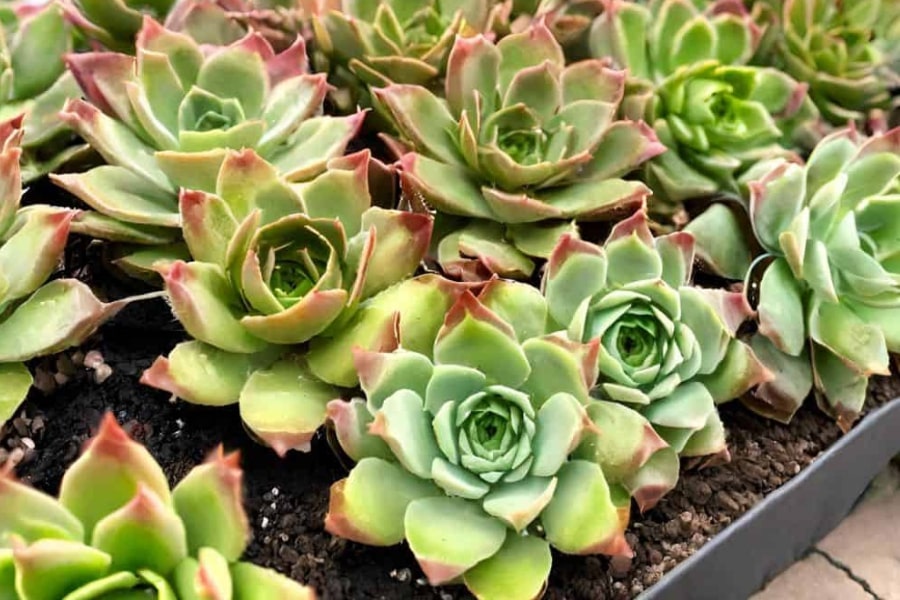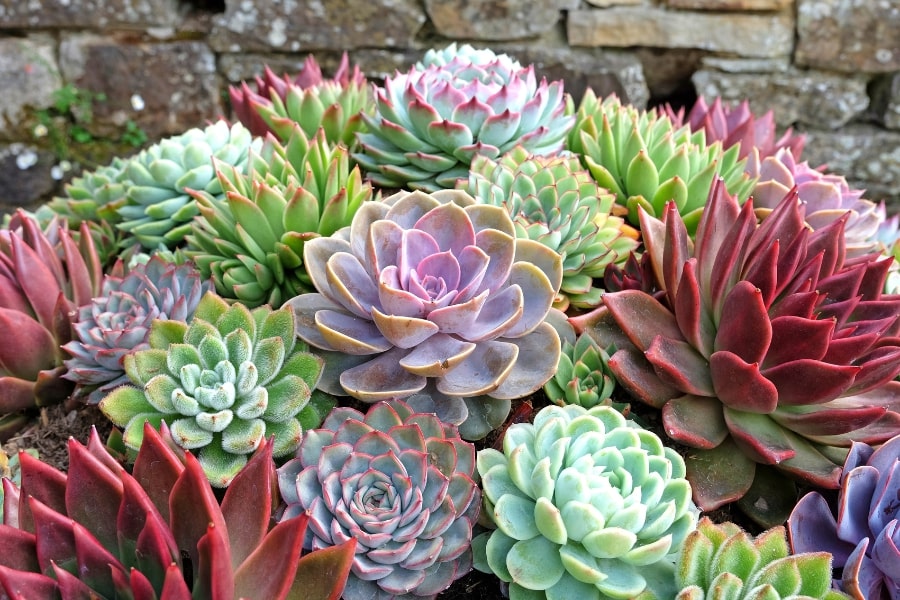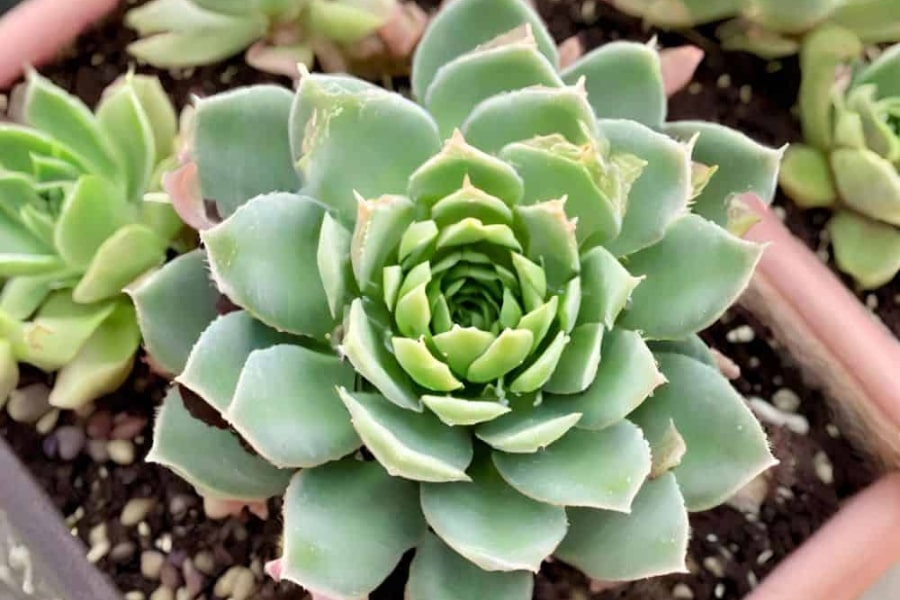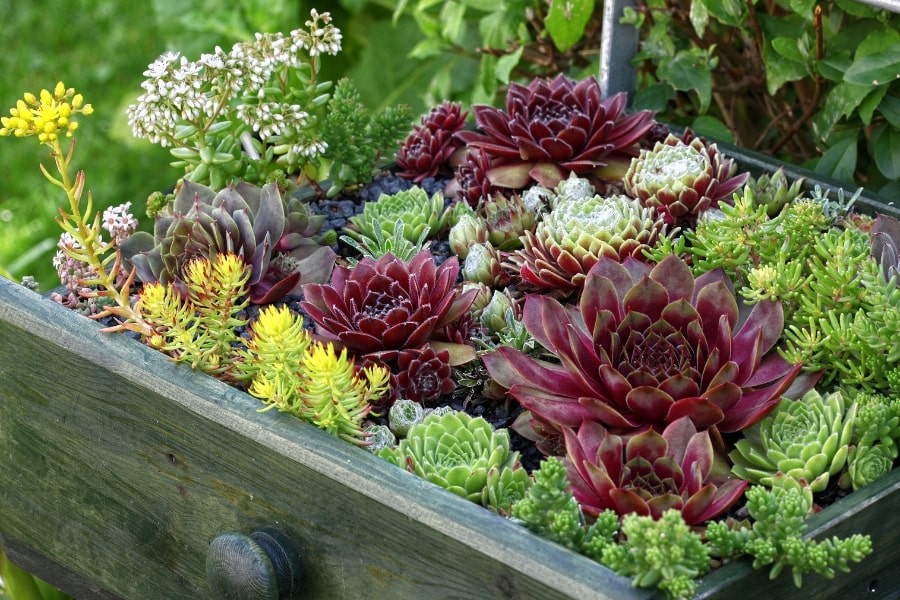Hens and Chicks, scientifically known as Sempervivum, are a group of succulent plants admired for their unique rosette forms and hardy nature. The name Sempervivum is derived from Latin, meaning “always alive,” a fitting descriptor for these tenacious succulents. Native to mountainous regions of Europe, the Middle East, and North Africa, Hens and Chicks have adapted to harsh conditions, displaying remarkable resilience and longevity. These plants are renowned for their rosette growth habit, where the “hen” (main rosette) produces offsets or “chicks” around its base.

Our Selection of Hens and Chicks
At Martin Garden Center, our 4″ Sempervivum are very popular, and we usually have them stocked year-round, with at least 3-4 species on our perennial tables. We also highly recommend our customers check our indoor Greenhouse, with 2″ varieties of Sempervivum, some of which are perennial.
We are carrying the following varieties in 2025:
- Black
- Carmen
- Cobweb
- Chick Charms Golden Nugget
- Chick Charms Lotus Blossom
- Commander Hay
- Kalinda
- Red Beauty
- Onyx
- Oddity
Growing and Caring for Hens and Chicks
- Hens and Chicks thrive in full sunlight. Plant them in a location where they receive at least 6 hours of direct sunlight daily. While they can tolerate partial shade, their vibrant colors are more pronounced in full sun.
- Well-draining soil is essential for the health of Hens and Chicks. They are particularly sensitive to waterlogged conditions, which can lead to root rot. A sandy or gritty soil mix is ideal, or you can amend the soil with perlite or pumice for improved drainage.
- Sempervivum are drought-tolerant and prefer to be on the dry side. Water sparingly, allowing the soil to dry out between waterings.
- Hens and Chicks exhibit excellent cold hardiness, making them suitable for various climates. They can withstand freezing temperatures and are often used in alpine or rock gardens.
- Sempervivum are prolific propagators. The “hens” produce offsets or “chicks” that can be separated and replanted to create new plants. This process is known as division. Sempervivum can also be propagated from leaf cuttings, where a healthy leaf is removed and allowed to root.
- Hens and Chicks are generally resistant to pests and diseases. However, overwatering or poor air circulation can lead to issues such as fungal diseases. Inspect the plants regularly and address any pest or disease concerns promptly.

Leaves and Flowers
The leaves of Hens and Chicks form dense rosettes, giving the appearance of a hen surrounded by her chicks. The leaves vary in color, size, and texture, with some varieties exhibiting a smooth surface and others displaying a powdery or hairy coating. The leaves are arranged in a spiral pattern, creating a striking and symmetrical effect.
Sempervivum produce flowers on tall stems that emerge from the center of the rosette. The flowers are typically star-shaped and can range in color from white to pink or red, depending on the species or cultivar. While the flowers add an extra dimension to the plants, Hens and Chicks are primarily valued for their ornamental rosettes.

Uses in Gardening and Landscaping
Hens and Chicks are perfect for rock gardens, where their low-growing and clustering habits create a visually appealing tapestry. Plant them between rocks or along the edges of pathways to mimic their natural alpine habitat. These plants are also well-suited for container gardening. Ensure the containers have drainage holes, use a well-draining soil mix, and provide ample sunlight. Container planting allows for easy movement and arrangement of these succulents.
You can arrange Hens and Chicks in containers or living wreaths for a unique and eye-catching display. Their diverse colors and forms allow for endless combinations, making them excellent choices for succulent arrangements. Use Hens and Chicks can also be used as ground cover to add texture and interest to garden beds. Their ability to spread and fill in spaces makes them effective for covering bare ground between larger plants.

Frequently Asked Questions
Are Hens and Chicks Perennial?
Yes, Hens and Chicks are perennial, cold-hardy succulents that can withstand freezing temperatures in the winter. Many varieties exhibit enhanced coloration during cooler months.
Can Hens and Chicks Grow Indoors?
While Hens and Chicks prefer outdoor conditions with ample sunlight, some varieties can be grown indoors in containers planted near a sunny window. Ensure proper drainage and acclimate them gradually to indoor conditions.
Are Hens and Chicks Poisonous to Cats and Dogs?
Hens and Chicks are generally non-toxic to humans and pets. However, keeping plants out of reach of curious pets and children is always advisable. Some individuals may experience skin irritation from the sap, so handling with care is recommended.
How Often Do You Water Hens and Chicks?
Hens and Chicks are drought-tolerant succulents that prefer well-draining soil and infrequent watering. After planting or transplanting, thoroughly water the hens and chicks to settle the roots into the soil. Allow the soil to dry out slightly between waterings to encourage root growth.
During the growing season (spring to fall), water hens and chicks when the top inch of soil feels dry. Depending on your climate and soil conditions, this might range from once every 1-2 weeks in hot, dry climates to once every 2-3 weeks in cooler, more humid conditions. In the dormant season (winter), watering is reduced significantly, as hens and chicks require less moisture during this time. Water sparingly only when the soil is completely dry, about once a month or less, depending on your local winter conditions.
Take natural rainfall into account when watering hens and chicks. If your region receives regular rainfall, you may need to water less frequently, while supplemental watering may be necessary in drought-prone areas. Avoid overwatering Hens and Chicks, as they are susceptible to root rot in soggy soil. Signs of overwatering include yellowing leaves, mushy stems, or wilting. If you notice these signs, reduce watering frequency and ensure the soil has proper drainage.
